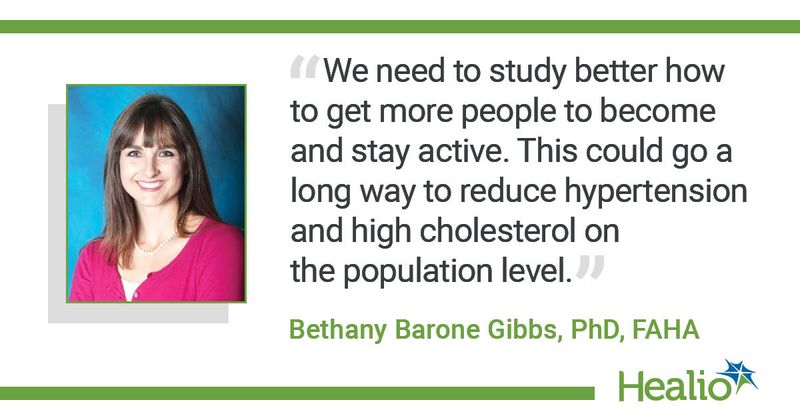AHA statement recommends increasing physical activity to reduce BP, cholesterol
A new scientific statement from the American Heart Association published in Hypertension recommends increasing physical activity to aid in lowering mildly to moderately elevated BP and blood cholesterol in adults.
“Though everyone should be prescribed healthy lifestyle, it is the first-line treatment for a large proportion of adults with mild to moderate elevations in blood pressure and cholesterol that are otherwise low risk,” Bethany Barone Gibbs, PhD, FAHA, associate professor in the department of health and human development and the department of clinical and translational sciences at the University of Pittsburgh, told Healio. “Prescribing physical activity is one of the best nonpharmacological options to treat elevated blood pressure and cholesterol and has many other health benefits.”

According to a press release from the AHA, 28% of U.S. adults have LDL levels greater than 70 mg/dL but meet the criteria for having low risk for CHD or stroke. Similarly, 21% of U.S. adults have systolic BP of 120 mm Hg to 139 mm Hg or diastolic BP of 80 mm Hg to 89 mm Hg, but many of them meet the criteria for having low risk for CHD or stroke, according to the release.
Lifestyle changes
For those populations, the statement highlights lifestyle changes to reduce elevated BP and cholesterol levels, including increased physical activity, weight loss, improved diet, smoking cessation and alcohol moderation.
The authors recommend 90 to 150 minutes per week of moderate to vigorous intensity aerobic exercise and 90 to 150 minutes per week of dynamic resistance exercise. These recommendations are based on previous research that demonstrated that more physically active individuals have a 21% reduced risk for CVD incidence and 36% reduced risk for CV mortality compared with those who are inactive. In addition, increased physical activity improves BP, cholesterol, dysglycemia, inflammation, hemostatic factors, body composition and vascular function, according to the authors.
Among individuals with overweight or obesity, experts recommend ideal body weight or a weight-loss goal of at least 5% to reduce BP and improve blood cholesterol. To do so, the statement highlights caloric restriction as the most recommended way to promote weight loss among these individuals. Weight loss demonstrated beneficial effects comparable to those observed with physical activity for both BP and blood cholesterol.
For an improved diet, the recommendations include consuming more fruits, vegetables, whole grains, low-fat dairy and seafood as well as regular intakes of legumes and nuts. In addition, reducing red and processed meat, refined grains, sugar-sweetened foods and beverages and lowering the intake of saturated fats and sodium also reduce risk for CVD.
Smoking, alcohol consumption
Although smoking cessation is not listed as the best lifestyle change to reduce BP and blood cholesterol, smoking is a big CVD risk factor. Smoking is known to have adverse CV effects, including high BP that increases the risk for CV events like stroke, so smoking cessation may improve both adverse outcomes, the authors wrote.
Heavier alcohol consumption is a large risk factor for reversible hypertension and is also associated with stroke and all-cause mortality. This new statement recommends reducing alcohol consumption to two drinks per day or less, as moderate alcohol consumption is associated with a 25% to 30% reduction in risk for CVD.
“We need to study better how to get more people to become and stay active. This could go a long way to reduce hypertension and high cholesterol on the population level,” Gibbs said in an interview. “Championing physical activity by prescribing it to patients could be part of that solution.”
For more information:
Bethany Barone Gibbs, PhD, FAHA, can be reached at bbarone@pitt.edu.
